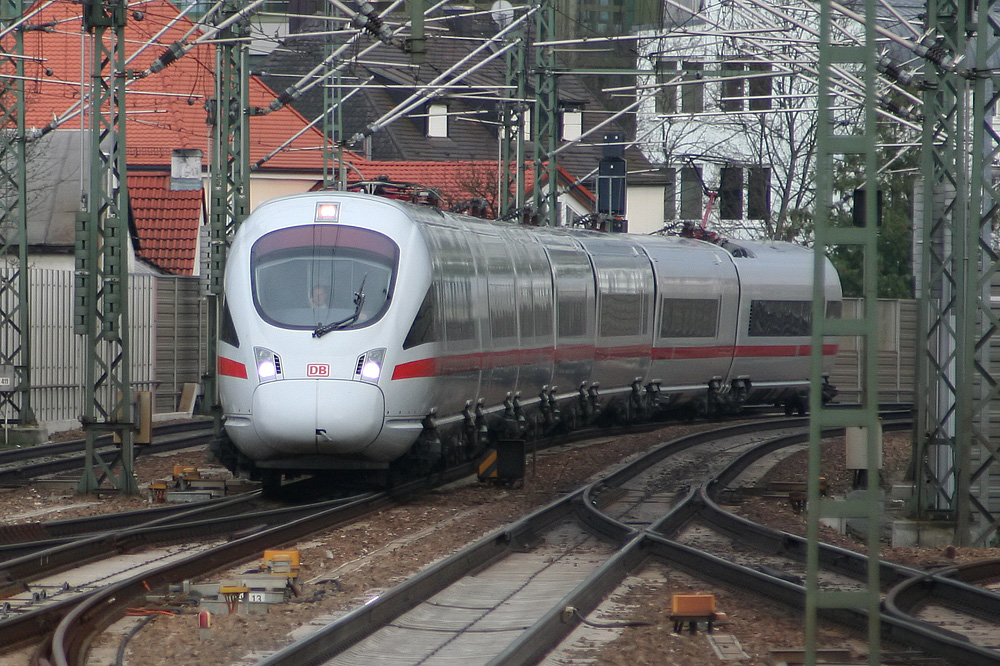- Siemens Venturio
Infobox Locomotive
name=Siemens Venturio
powertype=electric, diesel
caption=Class 411, tilting
builder=Siemens,Bombardier ,Alstom
builddate=1999-2004
totalproduction=50 class 411
11 class 415
20 class 605
electricsystem=15 kV 16.7 Hz AC
(class 411/415)
topspeed=230 km/h (class 411/415)
200 km/h (class 605)
poweroutput=4,000 kW (class 411)
3,000 kW (class 415)
2,240 kW (class 605)
tractiveeffort=200 kN (class 411)
150 kN (class 415)
160 kN (class 605)
safety=Sifa ,PZB 90,LZB ,Eurobalise Siemens Venturio is a product line of tilting high speed trains. It comprises class 411 and class 415 EMU and class 605 DMU, all in service with
Deutsche Bahn .Development
Following the successful inauguration of the
InterCityExpress system in 1991 and the order to develop the ICE 2, in 1994 DB started plans to expand the ICE network besides the newly built or reconstructed high speed lines. Whereas first plans were made for three-part EMU for use inInterCity andInterRegio services, it became apparent that these trains should run as ICEs. This explains why DB assigned the name "ICE-T" to later classes 411, 415 and 605 (with an additional "D" to indicate diesel traction), with the "T" originally not standing for "tilting", but for "Triebwagen" (railcar): DB's marketing department at first deemed the top speed too low for assignment of the InterCityExpress brand and therefore planned to refer to this class as "IC-T" (InterCity-Triebwagen). When changing the title to "ICE", the "T" remained part of the name for reasons unknown.In contrast to the first
ICE 1 and ICE 2 designs, the new units where not planned with power heads, but with peripheral underfloor motors, in order to reduce axle load (quite important for tilting trains) and increase power output. As the Siemens Venturio was developed parallel to the ICE 3, they share a lot of components and technical layout as well as design. All trains have a lounge section in the front cars that is separated only by a glass wall from the driver's compartment.Class 411 and 415
Class 411 entered service in 1999. The seven car units can be seen as DB's standard ICE-T tilting high speed units. Each train consists of two power units of three coaches plus one unpowered middle car. The middle car can be removed, and theoretically the trains can be supplemented with an additional middle car. Most trains have bee assigned city names. Starting 2006, DB has taken the second batch of 28 more class 411 units into service (also referred to as class 411.5). These newer models have a number of smaller modifications, mainly in order to make maintenance easier. The also offer 8 additional seats at a total of 390.
Of the 32 first batch units, 3 have been sold to Austria's
ÖBB as class 4011. Together with 12 DB class 411 they form a pool for joint operation services from Germany to Austria. On behalf of that, these trains were modified, including some software updates and, quite interestingly, clamps for ski transportation.Class 415 is the smaller brother of class 411, with only 5 cars. All cars are powered, an unpowered supplement middle coach could be added. Class 415 is mainly in service from
Stuttgart toZürich , therefore they are equipped with Swiss safety features also. When these five car trains turned out to be too small, in 2006 the end cars were switched with class 411 ones, thus forming seven car trains suitable for services to Switzerland.Class 605
Rather ill-fated was class 411/415's adoption for diesel services. In 2001 a total of 20 units were commissioned for use on the
Dresden -Munich line, but these ICE-TD units experienced trouble from the start. After the breaking of an axle in 2002, all remaining 19 units (one fell off a working platform) were grounded. Even though one year later the trains were admitted to service again, DB judged their operation to be overly expensive. DB must pay full diesel tax for the fuel. Today they are used for amplifier trains. Starting end of 2007, the class 605 is used on theBerlin -Hamburg -Copenhagen route as a replacement for the DanishIC3 trains used on Hamburg-Copenhagen (these should long ago been replaced by theIC4 trains, but due to technical problems those have not been commissioned yet byDanske Statsbaner . For these services class 605 is equipped with the Danish ATC safety system. Also they have from 2008 started to be used on Berlin-Hamburg-Århus (prevoiusly IC3 was used onFlensburg -Århus, and regional trains on Hamburg-Flensburg)Class 605 is powered by four diesel engines with 560 kW power each. These engines are based on engines for
truck s. The traction is diesel-electric with three-phase motors. Class 605 can be operated coupled together with class 411 and 415, even though this featured has not been used in regular service yet.See also
*Description of the InterCityExpress system in Germany
* Abstract on tilting trains in GermanyExternal links
* [http://references.transportation.siemens.com/refdb/showReference.do?r=369&div=7&l=en ICE T] Siemens Page
* [http://references.transportation.siemens.com/refdb/showReference.do?r=293&div=7&l=en ICE TD] Siemens Page
Wikimedia Foundation. 2010.
